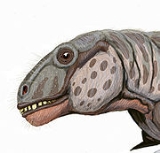
Anomocephalus
Encyclopedia
Anomocephalus is an extinct genus
of primitive anomodont
. Anomocephalus is primitive in that it retains a complete set of teeth in both jaws, in contrast to its descendants, the dicynodonts, in which the dentition is reduced to only a single pair of tusks (and in many cases no teeth at all), with their jaws covered by a horny beak similar to that of a modern tortoise
although they are in no way closely related. Its discovery in 1999 from the earliest terrestrial rocks of Gondwana
(from Williston
in the Karoo
of the Northern Cape Province of South Africa
) has shown that this group of herbivores originated in Gondwana rather than Laurasia
, as had previously been supposed. It lived 260 million years ago during the Permian
Period, in arid areas with rivers and lakes - almost like parts of modern-day Namibia
or Botswana
. It is closely related to Tiarajudens
from Brazil
.
Genus
In biology, a genus is a low-level taxonomic rank used in the biological classification of living and fossil organisms, which is an example of definition by genus and differentia...
of primitive anomodont
Anomodont
The Anomodontia were a major group of therapsids, an extinct group of animals commonly known as "mammal-like reptiles." They were mostly toothless herbivores. During the Middle Permian they were very diverse, including groups like the Venyukovioidea, the Dromasauria, the Dicynodontia, and early...
. Anomocephalus is primitive in that it retains a complete set of teeth in both jaws, in contrast to its descendants, the dicynodonts, in which the dentition is reduced to only a single pair of tusks (and in many cases no teeth at all), with their jaws covered by a horny beak similar to that of a modern tortoise
Tortoise
Tortoises are a family of land-dwelling reptiles of the order of turtles . Like their marine cousins, the sea turtles, tortoises are shielded from predators by a shell. The top part of the shell is the carapace, the underside is the plastron, and the two are connected by the bridge. The tortoise...
although they are in no way closely related. Its discovery in 1999 from the earliest terrestrial rocks of Gondwana
Gondwana
In paleogeography, Gondwana , originally Gondwanaland, was the southernmost of two supercontinents that later became parts of the Pangaea supercontinent. It existed from approximately 510 to 180 million years ago . Gondwana is believed to have sutured between ca. 570 and 510 Mya,...
(from Williston
Williston
-Places:United States* Williston Northampton School, a prep school in Easthampton, Ma* Williston, Florida, a city in Levy County* Williston, Maryland, a town in Caroline County* Williston, North Carolina, a village in Carteret County...
in the Karoo
Karoo
The Karoo is a semi-desert region of South Africa. It has two main sub-regions - the Great Karoo in the north and the Little Karoo in the south. The 'High' Karoo is one of the distinct physiographic provinces of the larger South African Platform division.-Great Karoo:The Great Karoo has an area of...
of the Northern Cape Province of South Africa
South Africa
The Republic of South Africa is a country in southern Africa. Located at the southern tip of Africa, it is divided into nine provinces, with of coastline on the Atlantic and Indian oceans...
) has shown that this group of herbivores originated in Gondwana rather than Laurasia
Laurasia
In paleogeography, Laurasia was the northernmost of two supercontinents that formed part of the Pangaea supercontinent from approximately...
, as had previously been supposed. It lived 260 million years ago during the Permian
Permian
The PermianThe term "Permian" was introduced into geology in 1841 by Sir Sir R. I. Murchison, president of the Geological Society of London, who identified typical strata in extensive Russian explorations undertaken with Edouard de Verneuil; Murchison asserted in 1841 that he named his "Permian...
Period, in arid areas with rivers and lakes - almost like parts of modern-day Namibia
Namibia
Namibia, officially the Republic of Namibia , is a country in southern Africa whose western border is the Atlantic Ocean. It shares land borders with Angola and Zambia to the north, Botswana to the east and South Africa to the south and east. It gained independence from South Africa on 21 March...
or Botswana
Botswana
Botswana, officially the Republic of Botswana , is a landlocked country located in Southern Africa. The citizens are referred to as "Batswana" . Formerly the British protectorate of Bechuanaland, Botswana adopted its new name after becoming independent within the Commonwealth on 30 September 1966...
. It is closely related to Tiarajudens
Tiarajudens
Tiarajudens is an extinct genus of saber-toothed herbivorous anomodont which lived during the middle Permian period in what is now Rio Grande do Sul, Brazil. It is known from the holotype UFRGS PV393P, a nearly complete skull. The type species T...
from Brazil
Brazil
Brazil , officially the Federative Republic of Brazil , is the largest country in South America. It is the world's fifth largest country, both by geographical area and by population with over 192 million people...
.

